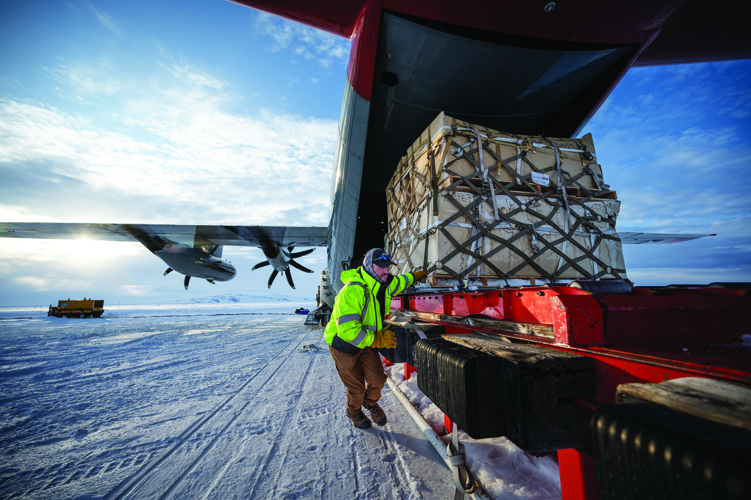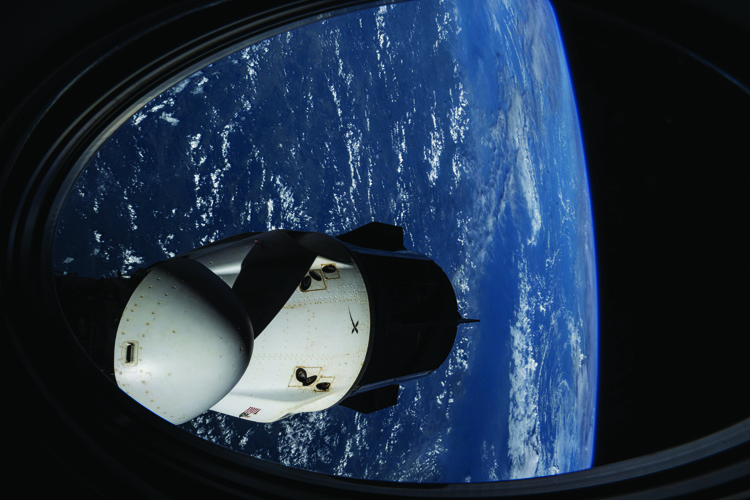Ice-Cold Yellow Jackets
By: Kelley Freund, Photography by: Cullen Welch, IE 13 | Categories: Featured Stories

Cullen Welch, IE 13, was just 6 years old when he saw a map of Antarctica. The big continent at the bottom of the world intrigued him, but what he didn’t know yet was that an entire community existed there. McMurdo Station at its summer peak is home to a little over 1,000 residents working in the name of scientific research ranging from astrophysics to geology. And for four Tech grads who crave exploration and the chance to work outside, it’s the perfect place to do just that.
All four alumni eventually found themselves working in Antarctic Terminal Operations (ATO), which is responsible for all cargo and personnel movements at McMurdo. Welch started out his time in Antarctica transporting people to and from the airfields and the Long Duration Balloon facility, a NASA-sponsored facility about five miles out on the ice shelf. Welch is currently the only ice-cold Yellow Jacket, spending the very dark winter season at McMurdo Station transporting people and cargo, serving on the search and rescue team, and participating in a NASA study regarding the effects of no sunlight on the human brain. The findings will be useful for future long-duration space flights.
Welch and three fellow Yellow Jackets landed gigs at ATO by taking paths not normally traversed by a typical Tech grad. Welch spent time as an underwater scuba photographer and sailed across the Atlantic Ocean in a sailboat. Margaret Milikin, ID 00, worked in Alaska and later for the National Park Service. Ethan Gehl, CE 08, hiked the Pacific Crest Trail and rode a bike across the country while volunteering for affordable housing organizations. And Ian Adams, ME 19, worked as a commercial fisherman and a wilderness guide.
Milikin, who is preparing for her 13th season in Antarctica, reached the bottom of the world first and jokes that she waited years for another Tech grad to show up. That alum was Gehl in 2022, followed by Welch in 2023, and Adams in 2024.
For Milikin, one of the best parts about her job as the airfield shift supervisor for cargo is working with the airplanes that fly into Antarctica. The airfields that service McMurdo are actually on the continental ice shelf, which means if you were to drill down 80 feet, you’d get to the ocean. The planes include Boeing C-17s; ski-equipped LC-130s, of which there are only about 10 currently in service for use in Greenland and Antarctica; smaller aircraft known as Twin Otters that travel to field sites that don’t have a full runway; and Baslers, which are modernized C-47 Skytrains from World War II. (One of these Basler airframes actually dropped paratroopers into Europe during Operation Market Garden in World War II.)
Welch now transports cargo at ATO, as did Gehl and Adams during their stints in Antarctica. The job involves the use of heavy equipment, including a modified mining dump truck outfitted with balloon tires to drive over the ice, to get cargo off and on the planes.
 From left to right: Ian Adams, ME 19, Ethan Gehl, CE 08, Margaret Milikin, ID 00, and Cullen Welch, IE 13
From left to right: Ian Adams, ME 19, Ethan Gehl, CE 08, Margaret Milikin, ID 00, and Cullen Welch, IE 13
But as the coldest, driest, and windiest continent on Earth, Antarctica is not a place where machinery was meant to survive. Milikin says the cargo team is constantly trying to make sure their equipment is functioning, and that means sometimes being resourceful. Milikin once had to draw up welding plans herself to get something repaired.
“I think something that would surprise people to know about McMurdo is that it’s full of artist-like people,” says Milikin. “There’s an immense amount of creativity that flows out of a place with limited resources and supplies.”
While Welch is in Antarctica now, Gehl is currently working in Alaska, bartending on the Wilderness Express, a tourist train that runs between Anchorage and Fairbanks. Adams works at the Alaska Volcano Observatory as a warehouse manager, with hopes to transition to field engineer, which would combine his love of engineering with being outdoors. And Milikin has a seasonal job with the National Park Service.
Living conditions in Antarctica are difficult. And yet Milikin is preparing to return later this year. And in 2026, Welch will be headed to the South Pole for nine months. Why return to such a challenging place every year? For Welch, he likes to know he’s part of something bigger than himself.
“We are supporting science and the frontier of human exploration,” he says. “The ATO department that we all worked for exists because scientists need to deploy to the near- and deep-field of Antarctica for important research with global and interplanetary impacts. The next step beyond Antarctica is to the stars. All of that feels deeply compelling and inspiring.”


